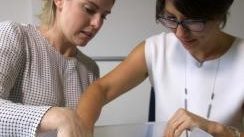
How close would you get to a big hairy huntsman?
Most of us would stay well away if we could, but for 5 per cent of the population the fear of an encounter with a spider is so pervasive that it has a disruptive effect on their daily life.
The majority of genuine arachnophobes are women, with some studies suggesting as many as 90 per cent of arachnophobes are female.
Researchers at the University of New South Wales think female sex hormones could be behind that imbalance.
They are investigating whether women are more likely to develop a fear of spiders and less likely to respond to treatment for their anxiety at times in their menstrual cycle when their level of sex hormones is lowest.
Briana Clifford is one of around 90 women who have been taking part in the UNSW study into the role hormones play in arachnophobia.
Briana cannot remember a time when she was not afraid of spiders.
"I just thought it was a normal response to be that scared of spiders all the time," she said.
"My dad is not afraid of spiders and I always thought it was super weird that he used to get rid of spiders for us and touch them and all that sort of thing.
"I make myself sound a bit like a crazy person but I always have a bit of a countdown of how long it's been since I've had any encounter with a spider.
"I feel like the longer between having an incident, the greater the chance of me coming into contact with a spider."
Ms Clifford is trying to stop herself engaging in excessive avoidance behaviours, where she fears that next encounter so much that she has to check under her bed and in every nook and cranny of her car before getting in.
"I know that most spiders are not poisonous, I know that and they are probably no going to hurt me but it's more the anticipation and anxiety of having a spider touch me or crawl on me," she said.
She has also been doing exposure therapy with the clinical psychologists at UNSW.
The therapy involves first talking about what exactly the patient fears will happen if they encounter a spider.
Dr Bronwyn Graham, a senior lecturer in the School of Psychology, said that information was crucial.
"Because rather than expose people just to spiders we want to expose them to the possibility that they fear," she said.
The exposure session for Ms Clifford involved first observing a St Andrews Cross spider, then picking it up using a postcard and a cup, then touching it, and finally letting it crawl on her hand.
She frequently leans back in her chair, jumps and squeals a few times, and shakes as she holds the spider in the cup.
Video: Watch Barbara Miller's report on arachnophobia and exposure therapy (Lateline)
No escape, no calling the spider disgusting
Clinical psychologist Dr Sophie Li said there were are a couple of rules for the session.
"One is no escape, which includes leaning back, and the second is no describing the spider as disgusting," she said.
The psychologists said a session like this, which can end in the patient going as far as touching a huntsman spider, can go a long way to curing someone of arachnophobia.
But up to 40 per cent of people experience no reduction in anxiety after exposure therapy and the researchers hope to show that the poorer results in women are linked to lower levels of sex hormones.
If that is proven, treatments could be scheduled at times in a women's cycle when their sex hormone levels are higher.
For women with low levels of oestradiol who have gone through menopause, hormones could be administered before the therapy session.
"If we demonstrate that there are fluctuations in treatment response due to hormone levels it would certainly have big implications for how we should be treating women in the future," Dr Bronwyn Graham said.
For Ellen Fawcett, another participant in the UNSW study, a two-hour exposure therapy session has had amazing results.
The social work student progressed from being hardly able to look at a spider, to letting one crawl on her hands.
"I feel like I have conquered the world," she said.
The researchers will also run a workshop for arachnophobes on May 13 at the Australian Museum.
This article by Barbara Miller appeared on ABC News. View the full article here: http://www.abc.net.au/news/2017-04-10/researchers-examine-the-role-of-sex-hormones-arachnophobia/8430566
